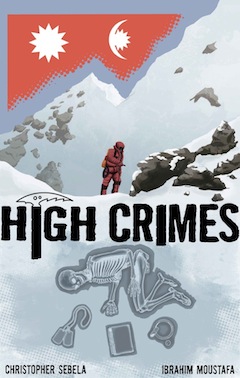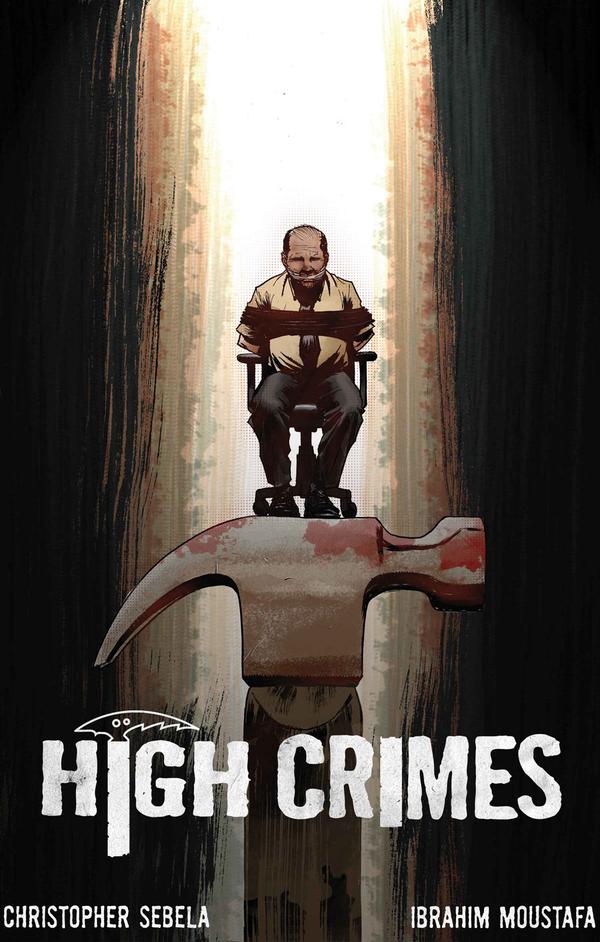“Suddenly I could see a gun getting pulled and an already hairy situation turning into an exciting bit of doom and gloom” High Crimes creator Christopher Sebela on his inspirations for mountain top crime drama
 How far would you go to earn a living? In the brilliant High Crimes from MonkeyBrain Comics lead characters Zan and Haskell go literally to the top of the world – Everest to be precise – in order to lower themselves to the bottom of the moral barrel as they attempt to swindle money out of the family’s of deceased climbers. With this brilliantly original premise at the heart of High Crimes we wanted to know whether writer Christopher Sebela was as intrepid as his lead characters and whether he would pay to get his loved ones off the worlds highest peak!
How far would you go to earn a living? In the brilliant High Crimes from MonkeyBrain Comics lead characters Zan and Haskell go literally to the top of the world – Everest to be precise – in order to lower themselves to the bottom of the moral barrel as they attempt to swindle money out of the family’s of deceased climbers. With this brilliantly original premise at the heart of High Crimes we wanted to know whether writer Christopher Sebela was as intrepid as his lead characters and whether he would pay to get his loved ones off the worlds highest peak!
 I love the premise of High Crimes tell us where the inspiration came from? Are either of you mountaineers or snowboarders or
I love the premise of High Crimes tell us where the inspiration came from? Are either of you mountaineers or snowboarders or
blackmailers ?
CS: The general premise, a crime book on and around Everest, has been in my head for several years now, but it’s only in the last 3-4 years that I started thinking specifically about it as a comic
and as an actual thing to write and finish, rather than just daydream about. The inspiration came from my 3rd or 4th re-read of Jon Krakauer’s Into Thin Air, reading a specific section, where suddenly I could see a gun getting pulled and an already hairy situation turning into an exciting bit of doom and gloom and it sort of spun out from there. My qualifications: I once climbed a very tall hill, I have a friend who is a snowboarder and I’ve done my fair share of blackmailing, but mostly the boring emotional kind.
I love the moral ambiguity of the main characters, they aren’t completely criminal but they also aren’t completely legal, that must be fun to write as it means you have a lot of flexibility in terms of where the characters can go, does High Crimes have a definite story arc or are you just waiting to see how it works out – it feels like it could go either way?
CS: There’s a definite story arc and a definite ending, all mapped out in my notes and beat sheets. It’s everything else leading up to the ending where the flexibility comes in. Working with Ibrahim has definitely changed my mind about certain things, made me want to explore other things and convinced me to ditch some dead weight I was holding onto for way too long. That and the characters themselves, now that we’ve gotten to live with them for a bit, it changes the way they act, or the way we think they should act, which is frustrating and great. This is the first time I’ve ever had that feeling that authors describe about writing, where they thought they were doing one thing and the characters tell them something else. In the end, we have to listen to our little babies, however unsavory they might be.
Recovering bodies from mountains is a pretty unsavoury way to earn a living, what’s been the worst job you have had and has any of that been carried through into Zan and Haskells attitude to their work?
CS: The worst job I’ve ever had is pretty boring, and none of the jobs I’ve ever had count as unsavoury, so I’ll go with my second worst job: working as an odd job monkey for a local Red Cross outfit. The work itself was unpleasant and unfulfilling and slightly creepy at times, like when I had to wipe down the baby CPR dummies and remove their faces to soak in cleaning solution. I hated it, but then I’ve pretty much hated every “real” job I’ve ever had. I’m sure a lot of that feeds into the book.
I think the job that’s most effected how I write Zan and Haskell’s approach to work is freelancing, which I’ve been doing for the last seven years or so, that freedom of movement contrasted with the constrictions of rent and bills, the wanting to do what you love smashing up against doing what you have to do.
Turning the thing you love to do into the thing you do for money, it’s a lot of existential dread minus the helpful “what am I doing” question that people like Zan specifically do their best to avoid dwelling on.
There’s a real mix of locations, from wintery mountain tops to grimey cities to the Winter Olympics and more, does this pose any particular challenges when writing or drawing them? What sort of source material or first hand info do you use and which are your favourite scenes for getting stuck into?
CS: There’s all sorts of challenges here, especially since neither of us has been to Kathmandu, the Olympics or Mount Everest, but the internet is magical place for photo reference, and the library remains an endless supply of source material. I’ve gone through guide books, photo albums, biographies of climbers and Everest disaster books, in addition to documentaries, cruddy reality tv shows and youtube videos. I occasionally feel like apologizing in my scripts when I write a new, reference-heavy scene, but I think Ibrahim relishes it and he never fails to completely nail it every time. I love the whole book. Initially, writing the pitch, I focused really hard on the big pieces, the explosive action scenes, the sort of tentpole moments that I always had in my head when I developed the idea, but along the way I’ve found I love writing the conversational back and forth between Zan and her friends as much as I like writing torture scenes that I’ve had stuck in my head for years and years. Every new page is a chance for me to uncover stuff I’d never even thought about, stuff that might inform things down the road and writing tricks I’d never had the chance or the temerity to use before.
 How do you find the writer/artist relationship, have you worked together before and what do you think each of you brings to the title?
How do you find the writer/artist relationship, have you worked together before and what do you think each of you brings to the title?
CS: This is our first time working together and it’s been the best collaboration I’ve had so far. We both bring a ton of enthusiasm and excitement for the project, which you need when it’s a big book like this. We work
tremendously well together, each of us doing our part in tandem so we can get the finished pages out, one of us working on one aspect while the other guy works on another. Me finishing the script is not the end of my involvement in that issue, and I want to try and bring as much work to the table as Ibrahim is. I’m not sure what I bring, other than the idea and the scripts. Ibrahim is a monster, he laughs at shortened deadlines, he encourages me to write more more more, way past my standard panel safety limit. He pushes both of us to work harder and do better and it definitely keeps me going when everything around me is threatening to crash in on my head.
MonkeyBrain are carving out a brilliant niche for themselves as a digital onlypublisher, what did they bring to the table for you and how do you think you fit in to the MonkeyBrain family?
CS: Simply, MonkeyBrain brought us a platform for High Crimes, and a carte blanche pass to go do the best possible book we could, without any interference, but with the occasional bit of helpful hand-holding on request. Chris and Allison just tell us the possible release schedule and leave it to us to hit our personal deadlines and then they blast it out to Comixology and do a lot of the legwork of helping promote the issue, which is one of the aspects of creator-owned I’m working on getting better at. Plus they are our last line of Quality Assurance. If we were turning in crap work, they’d be the first ones to tell us.
As to how we fit in the MonkeyBrain family, I’m friends with a lot of the creators on MonkeyBrain and an admirer of the stuff they do, so it’s sort of weird that they took us in at all. We’re the bloody, scrappy book that can’t stop sniffing its nose in polite company and doesn’t necessarily play well with others. But the great thing about MonkeyBrain is they have room for us too, however much we might bring down the property values.
Any plans to do any more digital only titles? And what do you make of the current rise of digital comics?
CS: Definitely, but down the road. Doing all the work we’re doing as the only two people working on each issue is a daunting task and we’re focusing on getting it right, so I’m not trying to mess it all up by taking on another creator-owned digital book. But I love digital comics and want to do more of them. I think the market’s only going to get bigger as technology gets cheaper and more widespread and it opens up avenues to creators who can’t sell their pitch to publishers or who, if they did, might get the axe before their story is fully told or have the kind of interference that turns the story you want to do into the story by committee. I think there’s a lot to be said for standing and falling on your own merits and digital is the great equalizer that gives you the room to do what you want, whether you fly or fall.
Finally, if you got a phone call in the dead of night to be told your loved one had been recovered from the top of Everest, would you pay up?
CS: Depends on how much I liked them and if they had anything of value on them. But even at the bargain extortion rates Zan and Haskell charge, I’d probably just leave them up there. If nothing else, they serve as tangible reminders to future climbers that this could be you if you screw up just once, which is way better than mouldering in a graveyard.
High Crimes is available for 69p/99¢ from MonkeyBrain Comics exclusively on ComiXology. For more information onf Christopher himself you can follow him on Twitter @xtop



Time travel, techno music and tannerins – we talk to Curt Pires and Dalton Rose about new series Theremin from MonkeyBrain Comics | Pipedream Comics
April 26, 2013 @ 9:24 pm
[…] a huge fan of the other MonkeyBrain stuff. I love Edison Rex, I love High Crimes, Knuckleheads is great, and the first issue of Skybreaker had me wanting more. I like the DC […]